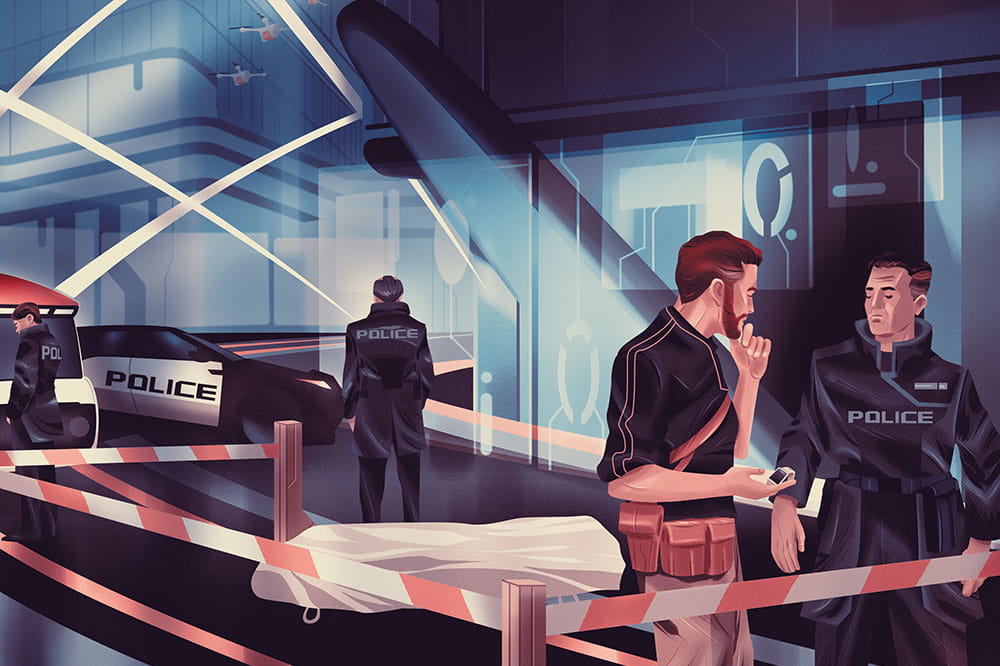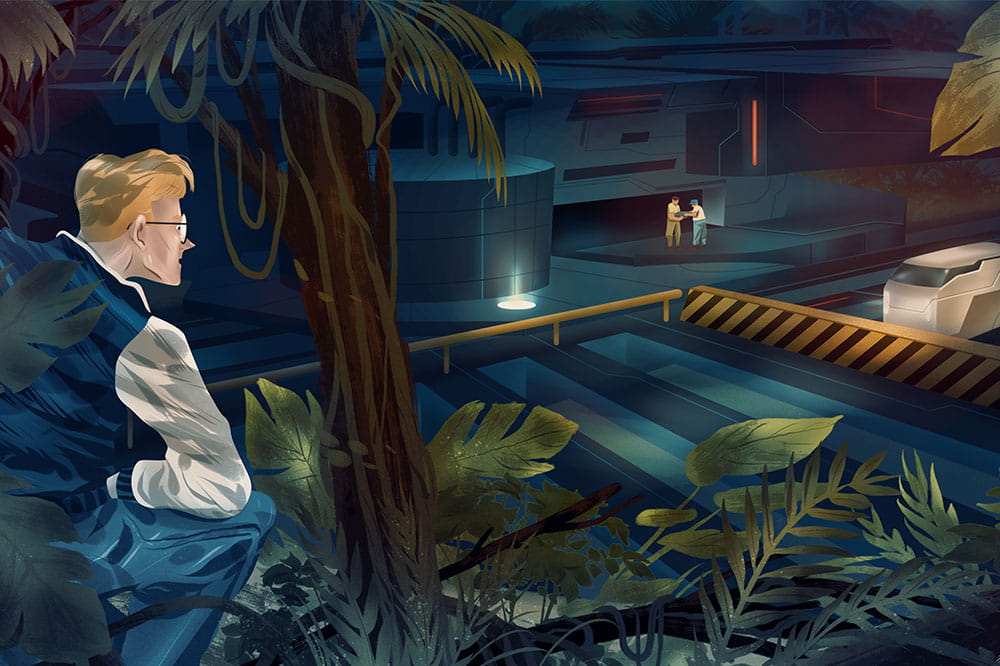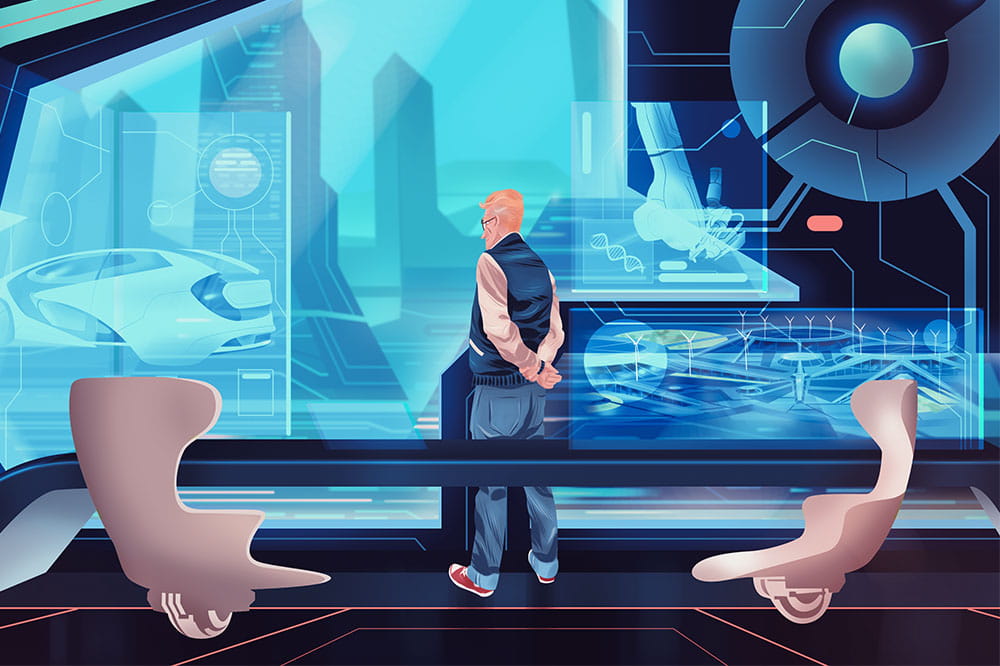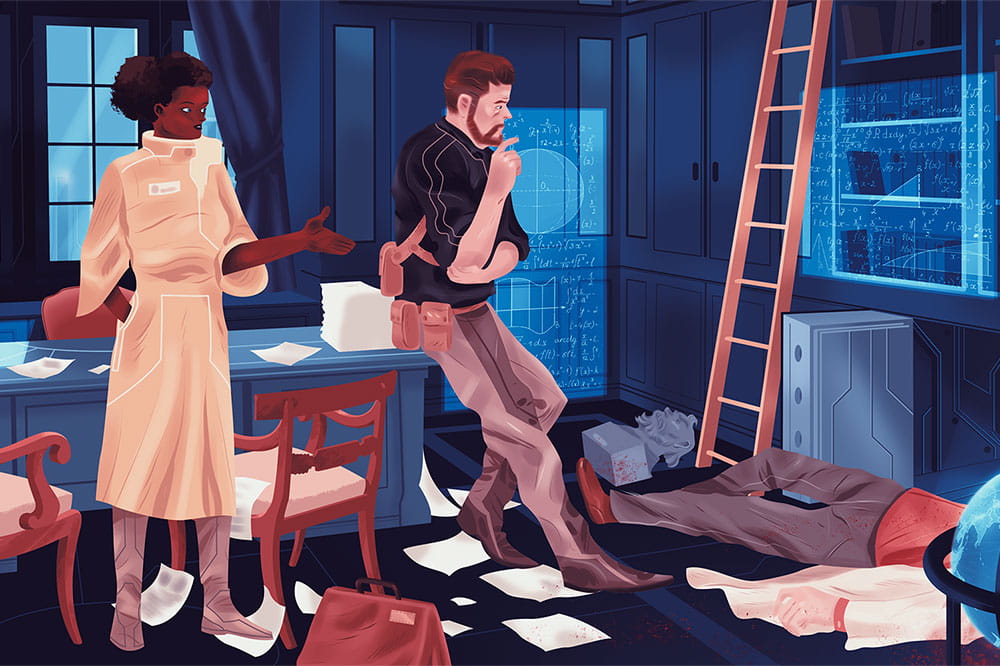Obtain news and background information about sealing technology, get in touch with innovative products – subscribe to the free e-mail newsletter.

19.12.2019 | Story
TRAVELING INTO THE FUTURE
Each month, you can find a new chapter in the ESSENTIAL science-fiction series “Trip into the Future.” In a fictional world where the goals of the Paris climate accord have become a reality, Nero, a blogger, explores the potential technological and social transformation resulting from it. The goal of the series is to play with fully different visions as creatively as possible and to take the reader along on a thought experiment: What might our future look like – and why is it important to us?
Short Science Fiction Stories: Volume 2, Part 4
Knowledge is the Opposite of Trust
Inspector Lee was dealing with his toughest case ever. The death of activist Hanna Karlsen was almost certainly a suicide, the artificial intelligence unit had told him. In fact, the probability was 99.7 percent. But during her lifetime, the anti-digitalization militant had feared retaliation from the artificial intelligence system. Just one more conspiracy theory? Lee learned that Karlsen had both a modern smartwatch and a wedding ring in her possession at the time of her death. Neither object seemed right for her. So he took up the case on his own..
Deep in thought, Inspector Lee twirled the golden wedding ring between his fingers. His colleague was standing in front of him and shaking his head:
“So you’re saying that Hanna Karlsen had never been married?
“No, she had not been. And I am quite sure that she didn’t run off and get married in the weeks before her death. The ring means something else.”
“A personal data storage unit perhaps? That would not be unusual,” Ortiz suggested.
“I saw no sign whatsoever of a solar cell or an integrated lithium ion battery. I held an energy scanner in front of it – there was no reading. In any case, if the ring is supposed to hold something – a storage medium, computer chip or energy cell, for example – it is either empty or switched off.”
“Maybe we should test it with a Geiger counter.”
Lee nodded. That would be a possibility. But he feared that the ring was just a solid piece of metal. He sighed. “Conspiracies, political entanglements, ant-digitalization activists – why are cases so complicated these days, Ortiz? In the good old days, murder still revolved around greed or classic cases of jealousy. Our lives were better back then.”
“I really don’t know if greed or jealousy is better than a political conspiracy, Lee…”
“It Sounds Like a Pretty Nasty Bug.”
“We won’t be making any progress on the ring right now. Look at what I found out about the smartwatch, Ortiz…” With his finger, he drew the sign for a new holo-window in the air. Naturally, the holographic image wasn’t responding to his finger but rather to the microchip implanted beneath a fingernail. He called up various messages about defects in the new Eriador XV smartwatch. There were indeed a few cases worldwide, and they had a few similarities.
“Here – and here,” Lee said. “The new smartwatch has led several owners astray, giving them bad information or malfunctioning at a crucial moment.”
Ortiz furrowed his brow. “That amazes me,” he said. “I remember the advertising. The manufacturer touted the smartwatch’s especially reliable security features, meaning that the watch would put up a fight if it were removed during a theft or mugging. If the watch is giving out false information, it must be infected with a pretty nasty bug.”
Lee pursed his lips: “Data and artificial intelligence are everywhere,” he said to himself. “When I was young, we made fun of the fact that self-drivers followed their navigation system so blindly that they steered their cars into rivers. But that was just the beginning. We want to believe the information because it is useful – it expands our knowledge to incredible levels.”

“My Shoes Generate Energy. That Makes Sense”
“At some point, we’re getting so used to having all the data that we no longer question anything,” Lee said aloud. “Here at the police department, people see me as a kind of a codger because I still don’t have an AI assistant, but I naturally enjoy all the benefits. Even my laundry conveys key health information in real time to my family doctor, where an artificial intelligence unit sounds an alarm if something changes drastically. After all, that is practical and potentially life-saving. My shoes count steps and generate energy from my movements. That makes sense. And so on.”
Ortiz smiled. “Years ago, I put on one of those ‘emotion’ wristbands that was supposed to read my current mood from my pulse rate, perspiration and other personal data so my devices know what music to play or whether I urgently need a cup of coffee.”
Lee raised an eyebrow. “And? Did it work?”
“No. Not very well in any case. But I heard that the new version is supposed to be better.”
“Here’s what I would say, Ortiz: Someone like me is considered a technology skeptic today because I don’t want to hand my case over to a police AI unit. I’m not a technology skeptic. it’s just that I…
“… got old?”
“Careful now.”
“What Do All The Victims Have In Common?”
Lee noticed that he had absentmindedly grasped the ring again, pressing down so hard that its imprint could be seen in his hand. By now, the tooth fillings that his dentist had wanted to sell him would have certainly have alerted him that he was stressed and that he would have neck tension and headaches because he was grinding his teeth. The inspector rubbed his temples. “Digitalization had started out so wonderfully. Artificial intelligence should help us filter out the patterns from large quantities of data that are invisible to us. Classic police work suddenly becomes a thousand times more effective: What do all of the victims have in common? Just a few seconds later, you have the answer.”
“Did you do that for these deaths based on their smartwatches?” Ortiz asked.
Lee stopped short. That was a good idea, actually.
“Computer,” said Lee, delivering an order to his own device, “I would like to have the commonalities in all these fatalities filtered out from the files on the deaths connected to the Eriador XV smartwatch. And please include the Hanna Karlsen case in the group.”
A red light told Lee that the computer was working.
“Hanna Karlsen Doesn’t Fit into the Sequence.”
It took minutes – not just a few seconds – but the results finally arrived. There in fact was a striking pattern filtered from the available data, chat logs and the evaluation of calls made by the victims. Each was either dissatisfied with the Eriador or wanted to get rid of it for other reasons. One had browsed through extensive test reports on other models. Another had the value of the watch estimated by an online pawnbroker. Lee presented the results as a holographic image in the room.
“Hanna Karlsen doesn’t fit into the sequence,” Ortiz noted.
Lee nodded. “There is barely a trace of her in the network. No unencrypted chats or conversations. This is odd even for an anti-digitlaization activist. If she has stored her communication somewhere, then we don’t have access to it.”
Inspector Lee drummed his fingers on the table top. It was fortunate that he had deactivated one function months earlier: The drumming would have automatically ordered coffee from the police kitchen otherwise. Then he thought about what Nero, his secret partner, had communicated from Rome that morning: Besides the report of a burglary, he had made a few strange remarks about the similarities people and machines – both could unlearn and forget things if they were not important.
A question occurred to him: Would he now have to view machines in much the same way he views people?

“What If Smartwatches Learned from This…?”
“I have an idea, Ortiz, but I don’t really know whether it’s rational or crazy. Help me with it: These smartwatch things are supposed to know as much as possible about their owners, right?”
“Yes. To some degree, they replace AI assistants, but with a retro feel.”
“What was it that you said about these sketchy antitheft devices. The wristbands know when they are stolen?
“That’s right. A sensor recognizes when they are removed from the wrist. We know artificial intelligence is at work here. The details are proprietary. The manufacturer presented this as one of the world’s great wonders.”
“Now imagine this, Ortiz: What if the smartwatches learned they were going to be switched… And what if the artificial intelligence system tried to prevent this at any cost? Because the watches misunderstood their programming or the artificial intelligence system had been thinking much further ahead and much more systematically than they were supposed to?”
“The wristbands killed their owners so they wouldn’t be able to switch them?” Ortiz looked at his colleague in horror.
“Wouldn’t that be logical from the standpoint of an algorithm that has been programmed to prevent theft?”
“In any case, and from any standpoint, it would be slipshod programming.”
“Or especially good programming that gave the AI function greater developmental scope than had been planned.”
“AI Seized by Jealousy, so to Speak…”
The only thing left to do is demonstrate that Hanna Karlsen was killed by her smartwatch for that reason, Lee thought. But that would explode the grand conspiracy theory. He wouldn’t find a system retaliating against anti-digitalization activists. It would all come down to a kind of programming error and an irresponsible manufacturer. It’s no surprise that the company had recalled the devices.
“Artificial intelligence seized by jealousy, so to speak,” Ortiz observed thoughtfully. “Didn’t you say earlier that you would prefer to see your cases revolving around jealousy and emotions again to a greater extent?
“I was thinking more in terms of marital troubles, Ortiz.”
Which brought him back to the wedding ring.
Lee stood up and took a couple steps around the room. Sometimes that helped him think. A very soft humming sound announced that his shoes had begun to transform and store the energy generated by walking. Scientists were presumably tinkering with the transformation of body heat from socks into energy as well.
Lee stopped for a moment.
“Body heat!” he said out loud. He put the ring on his finger. Soon it made an extremely soft humming sound. Inside, a hard drive or computer chip was activated by the heat.
“And I’ll bet the password is the day she chose for her wedding,” Lee said to himself.
The golden wedding ring contained lots of conversations, private chats and dates that Hanna Karlsen had moved into its storage function. It took Lee an entire day to develop an overview of the information. He wasn’t interested in the controversial plans for political anti-digitalization campaigns. He was only looking for conversations where Karlsen mentioned her smartwatch. And that’s what he found: She had apparently only bought the watch for its special interface for data transmission. She planned to get rid of it immediately afterwards, according to a conversation she had with a friend.
“So now we have the connection,” Lee murmured to himself.
But if there were no broad AI conspiracy, why did the police computer pull the case from him? And why hadn’t the police AI function run into this remarkable connection a while ago?
[Inspector Lee finds the answers to these questions in the sixth and final chapter…]
More Stories About Future Files
More news on the subject General

Join Us!
Experience Freudenberg Sealing Technologies, its products and service offerings in text and videos, network with colleagues and stakeholders, and make valuable business contacts.
Connect on LinkedIn! open_in_new

















